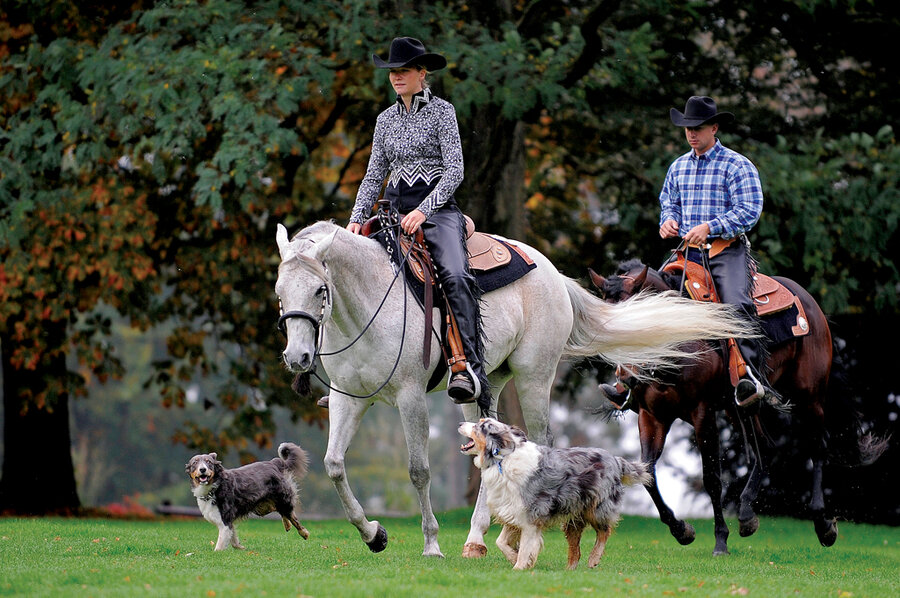Cowboy culture in suburban Bavaria: 'Wilkommen pardner!'
Loading...
The most successful American export of all time is not a product or even a tangible object. It is, rather, a concept, an idea – an image that has become firmly entrenched in the global psyche.
To hundreds of millions of people across the planet, when you say "American" you are really saying "cowboy."
The American West and the cowboys who rode its ranges are such enduring icons of this country that they eclipse all other contenders. Just about everyone, everywhere, has an ongoing love affair with the idea of the lone cowpoke on horseback, a fellow as tough as saddle leather but as kindly as the schoolmarm he vows to protect.
In many places around the world the fascination with cowboys and the American West reveals itself in music. I have heard home-grown country bands from Austria to Australia, and all have been terrific. Indeed, one of the most popular musical groups in Nagoya, Japan, is Cussy & The Aus City Limits, a local bunch that performs with such skill and enthusiasm that I once told pedal steel guitar player Hideo "Buddy" Hebisawa that he should be playing in Nashville, Tenn. He laughed heartily at that, but then he assumed a serious mien and bowed his thanks for the compliment.
But if much of the world has adopted peripheral aspects of western culture, it is in Germany that you will find an almost fanatical devotion to the Cowboy Way. My friend Gunther is not atypical. During the workweek he is a respected professional. On weekends, however, he transforms himself into a character who could answer to the name "Tex."
Gunther belongs to the local Schützenverein – technically, the "Königlich privilegierte Schützengesellschaft," or "Royal Privileged Protection Society" – which was formed in the 15th century as a corps of riflemen who volunteered to protect the community from outside threats. Those threats disappeared quite a while ago, so the corps eventually became a simple club of shooting enthusiasts. But not just any shooting enthusiasts.
Not long ago, Gunther invited me to stop in when he would be spending the whole day at the clubhouse with his mates.
"Willkommen, pardner," he said as I entered, and I would have replied had I not been speechless. There stood Gunther, wearing bluejeans, an enormous silver belt buckle, checked shirt, red bandanna, fringed leather vest, cowboy boots – complete with silver spurs – and a leather holster in which reposed a real six-shooter.
Gunther gave me a tour of the club, which had both indoor and outdoor shooting ranges. Interior walls were decorated with prints of cowboys in action, reproductions of photos of Wyatt Earp and Billy the Kid, and even stills from various western movies.
As he introduced me to other members of the club, Gunther pointed out that all of their guns were authentic replicas of 19th-century arms used in the American West, from Winchester repeating rifles to Colt revolvers. Everyone was dressed in western garb, from Stetsons down to chaps, and they all seemed to affect a cowboy swagger that may or may not have been the result of trying to walk normally while wearing those stirrup-friendly boots.
It was, as you might imagine, bizarre in the extreme. After all, how often does one encounter a bunch of cowpokes speaking guttural Bavarian German as they finger their shootin' irons and the keys to their Audis? To them, though, it was all as normal as sunshine.
I asked Gunther what lay at the root of the German fascination with cowboys. His opinion was that the romance of the American West – wide open spaces, the freewheeling loner, and so on – may be mythic in part, but it still holds a powerful allure for people like him, used to living in relatively cramped and socially hidebound countries.
He also mentioned a man named Karl May, a German writer who produced a series of western tales early in the 20th century. Every German boy grew up reading May's stories and believing them unreservedly, despite the fact that the author himself never set foot in the United States.
I had heard about May from almost every German and Austrian male I had encountered in my travels, but Gunther added an interesting personal twist. Gunther grew up in East Germany, where there were few movies from the West and where the quality of television programming was less than stellar. The only entertainment that he and his friends had as youngsters was reading, and Karl May was at the top of their list.
"Much better," he said, "than Karl Marx."





